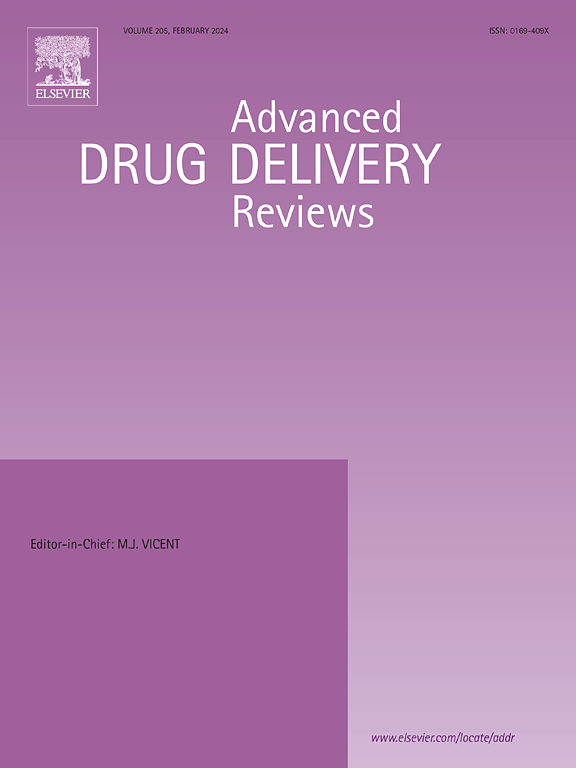基于适配体的癌症基因治疗及其他方面的应用:最新进展和临床转化的缺失环节
IF 17.6
1区 医学
Q1 PHARMACOLOGY & PHARMACY
引用次数: 0
摘要
通过基因治疗纠正遗传和表观遗传改变的可能性被认为是肿瘤学的基石。然而,在临床中取得的效果有限,主要是由于肿瘤靶向性低和副作用。核酸适体是三维折叠的单链dna或rna,它们选择性地结合细胞膜上的受体,随后通过受体介导的内吞作用被内化。由于这种能力,内化适体已经被研究为靶向部分,以更有效和选择性地在肿瘤细胞中提供基因治疗。有希望的临床前结果表明,适体可能代表着期待已久的癌症基因治疗向前迈进了一步。然而,在首次临床前应用20年后,没有进行基于适配体的基因治疗的临床试验,这表明该领域的可翻译性还不够成熟。该综述旨在更新适体对基因治疗递送的贡献的最新技术状态,并批判性地强调可能阻碍临床评估的主要缺点。此外,本文还总结了在CRISPR/Cas9技术中使用适体作为辅助因子或作为直接表观遗传调控因子的开创性见解,揭示了更广泛的适用性,而不仅仅局限于癌症基因治疗的传递。本文章由计算机程序翻译,如有差异,请以英文原文为准。


Aptamer-based applications in delivering cancer gene therapies and beyond: state of the art and the missing links to clinical translation
The possibility of correcting genetic and epigenetic alterations through gene therapies has been considered a cornerstone in oncology. However, modest results have been achieved in clinics, mainly due to inefficient tumor targeting and side effects. Nucleic acid aptamers are three-dimensional folded single-stranded DNAs or RNAs that selectively bind receptors on cellular membranes, being subsequently internalized via receptor-mediated endocytosis. Thanks to this capability, internalizing aptamers have been investigated as targeting moieties to deliver gene therapies more efficiently and selectively in tumor cells. Promising preclinical results suggested that aptamers could represent the long-awaited step forward in cancer gene therapy. Nevertheless, no clinical trials of aptamer-based gene therapies have been carried out two decades after the first preclinical application, indicating the field could not be sufficiently mature for translatability.
The review aims to update the state of the art regarding aptamers’ contribution to gene therapy delivery and to critically highlight the main shortcomings that could have hindered clinical evaluations. In addition, pioneering insights regarding the use of aptamers as co-factors in CRISPR/Cas9 technology or as direct epigenetic regulators are also summarized, revealing more extended applicability not limited to the delivery of cancer gene therapies.
求助全文
通过发布文献求助,成功后即可免费获取论文全文。
去求助
来源期刊
CiteScore
28.10
自引率
5.00%
发文量
294
审稿时长
15.1 weeks
期刊介绍:
The aim of the Journal is to provide a forum for the critical analysis of advanced drug and gene delivery systems and their applications in human and veterinary medicine. The Journal has a broad scope, covering the key issues for effective drug and gene delivery, from administration to site-specific delivery.
In general, the Journal publishes review articles in a Theme Issue format. Each Theme Issue provides a comprehensive and critical examination of current and emerging research on the design and development of advanced drug and gene delivery systems and their application to experimental and clinical therapeutics. The goal is to illustrate the pivotal role of a multidisciplinary approach to modern drug delivery, encompassing the application of sound biological and physicochemical principles to the engineering of drug delivery systems to meet the therapeutic need at hand. Importantly the Editorial Team of ADDR asks that the authors effectively window the extensive volume of literature, pick the important contributions and explain their importance, produce a forward looking identification of the challenges facing the field and produce a Conclusions section with expert recommendations to address the issues.

 求助内容:
求助内容: 应助结果提醒方式:
应助结果提醒方式:


